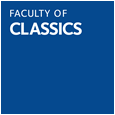Extract: Pindar's Dithyramb opens with a reference to the historical development of the genre it exemplifies, the celebrated circular chorus of classical Greece. The first two lines were long known from various citations, notably in Athenaeus, whose sources included the fourth-century authors Heraclides of Pontus and Aristotle's pupil Clearchus of Soli. The third line appears, only partly legible, on a papyrus fragment published in 1919, which preserves some thirty lines of the dithyramb including most of the first antistrophe (thereby guaranteeing the metre for some reconstruction of the first strophe).



